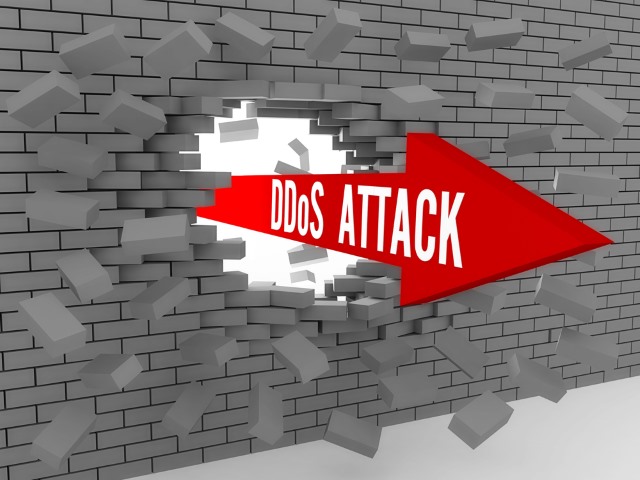
DDoS attacks intensify in 2020 -- driven in part by COVID-19 and 5G
Cybercriminals had a busy year in 2020, with rapidly increasing numbers of distributed denial of service (DDoS) weapons, widespread botnet activity, and some of the largest DDoS attacks ever recorded. As COVID-19 drove an urgent shift online for everything from education and healthcare, to consumer shopping, to office work, hackers had more targets available than ever -- many of them under protected due to the difficulty of maintaining security best practices in an emergency scenario.
At the same time, the ongoing rollout of 5G technologies has accelerated the proliferation of IoT and smart devices around the world, making unsuspecting new recruits available for botnet armies to launch crushing attacks on a massive scale.

Protecting your business from increased digital risk
Business conversations have included digital transformation for decades. However, more recent innovations have made it much easier for businesses to seamlessly integrate digital technology into their operations.
While these technologies improve efficiency, support personalization, and promote safety, they also challenge risk managers to protect company information, prevent data breaches, and reduce potential threats that can accompany doing business with third-party vendors.

Unlocking business potential by integrating telecom APIs
Today’s business leaders are faced with competing challenges and uncharted waters as they continue to navigate the impacts of COVID-19. During the past year, we’ve seen a rise in e-commerce and increased reliance on the cloud to facilitate communications and collaboration and support contactless services.
As business and IT decision makers look to capitalize on new or existing cloud investments and accelerate digital transformation efforts, implementing nimble IT resources is an essential component of the process and will set businesses up for long-term success. Getting the most out of their investment means taking advantage of every opportunity to improve operations and customer experiences through seamless integrations. One such technology that can help in this regard is APIs.

What we can learn from organizations who flourished during COVID?
When the knock-on effects of the coronavirus pandemic and subsequent UK lockdowns are discussed, much of the focus is on the negative impact on the economy, our physical health, and our mental health. But, while the damaging effects are unlike anything we’ve ever witnessed, it’s not all doom and gloom.
While many businesses have suffered as a result of the pandemic, others have flourished. Exercise equipment, homeware, DIY, and gardening retailers, amongst others, were some of the businesses that flourished during the first national lockdown. When it comes to business-to-business, technology providers, ecommerce sites, video conferencing software solutions, and healthcare providers led the way. So did the companies who tapped into their services.

Why price doesn't equal cost in the cloud
Saving money in IT has always been an important consideration, but due to COVID-19 many corporate strategies and budgets have been pushed off course. For example, relative to pre-COVID levels, the likelihood of undertaking cost reduction initiatives has increased globally by 74 percent, 66 percent of companies are now expected to pursue cost reduction strategies over the next 12 months and it is predicted we will see a 38 percent increase in these cost reduction strategies in the next 12 months, compared to pre-COVID times.
Due to the need for greater flexibility caused by COVID-19 and the need to secure these cost reductions, many organizations are now looking to the cloud. Cloud spending rose by 37 percent to £20 billion during the first quarter of 2020 and, according to Gartner, we saw a 19 percent growth in cloud spending in 2020 even when IT spending overall was down by 8 percent. It goes without saying that there are many benefits to moving to the cloud, one of them being cost reductions, with others including agility, flexibility, scale, working from home capabilities and the transfer of budget allocations from CapEx to OpEx.

If I knew then what I know now -- Zero Day Vulnerabilities and why we should confine the unknown
When Donald Rumsfeld gave a briefing about the Iraq WMD program in 2002 (Iraqi Weapons of Mass Destruction were a major justification for the second invasion) he said "There are known knowns. There are things we know we know. We also know there are known unknowns. That is to say, we know there are some things we do not know. But there are also unknown unknowns, the ones we don't know we don't know."
At the time, many mocked this word-salad as the Secretary of State for Defense delivering an over-complicated and evasive way of admitting that they had no evidence of WMDs in Iraq -- not yet at least. Even so, there is some undeniable logic in accepting that there can be unknown unknowns, and not just in the field of counter intelligence but in cyber security too.

Why has Google become 'gambling loyal'?
Just a few years ago, Google opened up Google Play to real-money gambling apps in a limited number of countries, including the UK, Ireland, France, and Brazil. Before then, any app of that kind was totally prohibited for hosting in the official Android app store.
Starting from March 1, the new phase of real-money gambling app legalization in Google Play commences. Google now allows gambling and betting apps to be published in its Google Play Store. Generally, the policy change will have a positive impact on the gambling markets in an additional 15 countries, including English-speaking USA, Canada, Australia, and New Zealand, as well as local markets in Belgium, Colombia, Denmark, Finland, Germany, Japan, Mexico, Norway, Romania, and Spain.

Essential points to know before implementing a cybersecurity transformation program
In light of the recent explosion of cyber attacks and the changes brought about by the pandemic, there appears to be a compelling need for cybersecurity transformation. Businesses have to update their cyber defenses or risk the possibility of falling prey to persistently sophisticated attacks.
Transforming an organization’s security posture, however, is not as easy as it sounds. It takes time, expertise, and resources. One bad decision or an inadequacy in the technologies employed will render the transformation useless. Things can even become worse than the previous state. To make sure that it yields the expected benefits, organizations need to do it correctly.

In the As-a-Service economy, 'subscription' without 'service' just won't fly
As we think about the past year in business, the subscription and "As-a-Service" economy has to be at the top of the trend lists. There is a difference between products on subscription and a true service. Take consumer services as an example.
Consumer-oriented grocery delivery, shipping services, videoconferencing and entertainment solutions all have seen tremendously accelerated adoption in the months since the onset of the pandemic. And these services in turn are convincing reasons to adopt IT infrastructure as a service, cloud, and sophisticated third-party logistics services. Getting what you need, when you need it, and only paying for what you use are the new standards by which businesses are measured.

How advancing AI is being used to enhance player experience
When it comes to delivering an immersive, exciting, and balanced gaming experience for the player, AI is certainly one of the focus points for developers. From building realism in a virtual world to making sure a game adapts to skill level, it has an increasingly important role to play in the industry.
To take a quick temperature check on the importance of AI for gamers, just look at what can happen when things aren't up to scratch. It was impossible to miss the burning wreckage of Cyberpunk 2077 as it came crashing down last year, with a buggy and faulty AI on display for all to see (among all the other issues). The internet was quickly filled with clips of enemies spawning out of the ether and cars circling the same roundabout ten times before vanishing. The bugs were enough to ruin the game's launch for many, with underperforming sales the end result.

Why supply chains are today's fastest growing cybersecurity threat
Business ecosystems have expanded over the years owing to the many benefits of diverse, interconnected supply chains, prompting organizations to pursue close, collaborative relationships with their suppliers. However, this has led to increased cyber threats when organizations expose their networks to their supply chain and it only takes one supplier to have cybersecurity vulnerabilities to bring a business to its knees.
To this point governments around the world have highlighted supply chains as an area for urgent attention in tackling cyber risk in the coming years.

Fresh ideas: How Amazon Is transforming the grocery industry
Since the first supermarket was opened in the US in 1930, the industry hasn’t changed much. Supermarkets are handy places for us to go and pick up what we need, when we need it, all from one place. It’s fair to say that expectations are limited when it comes to supermarkets -- customers know what’s coming: baskets, shelves, and checkouts. However, this all changed when Amazon opened its first physical grocery store location in 2018, Amazon Go.
The move created shockwaves throughout the grocery industry for one major reason -- there are no checkouts at Amazon Go. In this article, we look at all the latest grocery innovations Amazon has brought to the table.

Tightly knit information security and knowledge management together
Cyber criminals have thrived during this pandemic. In the first quarter of 2020, DDoS attacks rose by 278 percent compared to the corresponding quarter in the previous year. UK business alone are estimated to have lost over £6.2 million to cyber scams through social engineering. Globally, taking advantage of people’s vulnerabilities and the overnight pivot to 'working from home', fraudsters tricked people into clicking on links to download malware and collect confidential corporate information. Threats of ransomware increased as well.
It’s no surprise then that to combat this situation, many enterprises, and especially professional services firms, who have long been targeted by cyber criminals, view adopting need-to-know security measures as a priority. It presents a sound way to restrict access to corporate data to those who need it or are authorized to view the information in today’s 'work from anywhere' business environment.

North star metrics for security operations
The Solarwinds case has cemented the role of enterprise security in protecting business risk and advancing resiliency. As security continues to elevate and garner a seat at the board-level, we need to rely less on articulating the Fear, Uncertainty and Doubt (FUD) and rely more on communicating in terms of clear operational metrics as a way of establishing a baseline and goals in language the board can understand.
In the last year, we’ve seen a step-change in adoption of Mean-time-to-Detect and Mean-time-to-Respond as the core metrics forward-thinking security leaders are adopting as the north star metrics for their organization.

5 emerging smart industries in 2021
Though almost all businesses use technology to some degree, some take it to new heights by creating an entire smart industry. With the COVID-19 pandemic as a leading factor that’s forcing change, 2021 will solidify five main smart industries as norms.
Now, as tech leads these industries into the technological future, it’s likely that the smart changes will remain after the pandemic ends.

